2026届高考英语二轮复习: 非谓语 课件(共34张PPT)
文档属性
| 名称 | 2026届高考英语二轮复习: 非谓语 课件(共34张PPT) |  | |
| 格式 | pptx | ||
| 文件大小 | 1.8MB | ||
| 资源类型 | 教案 | ||
| 版本资源 | 通用版 | ||
| 科目 | 英语 | ||
| 更新时间 | 2025-06-19 09:46:24 | ||
图片预览

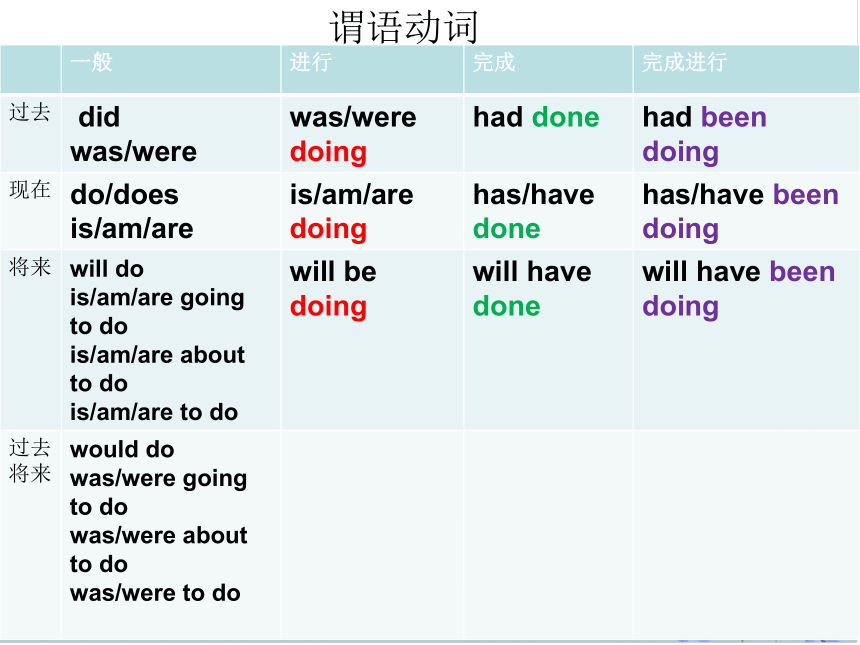
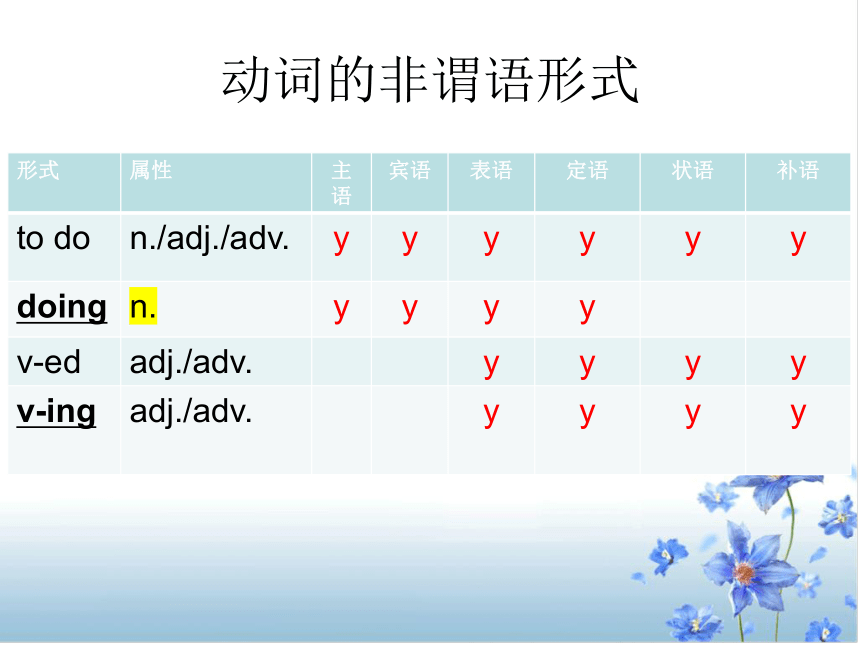


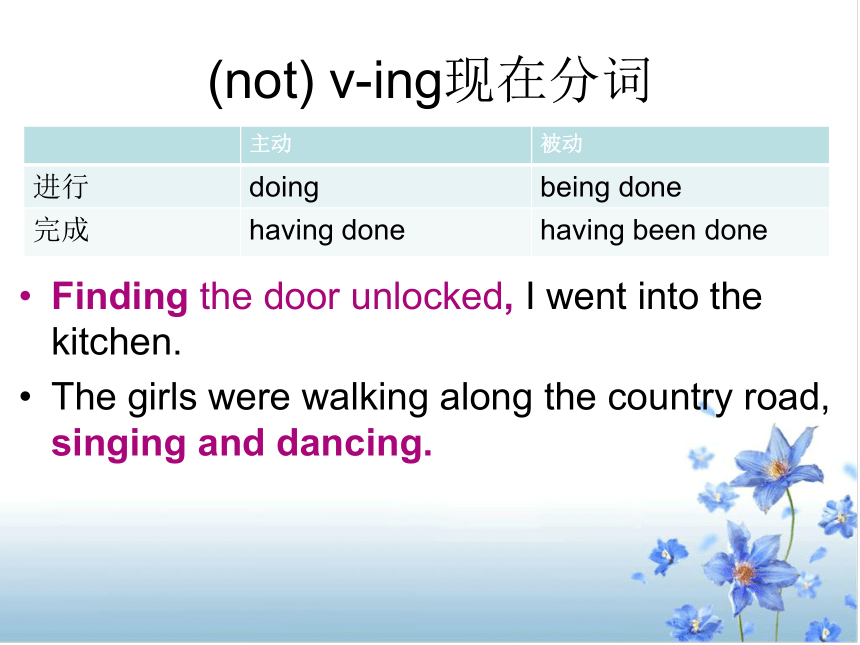
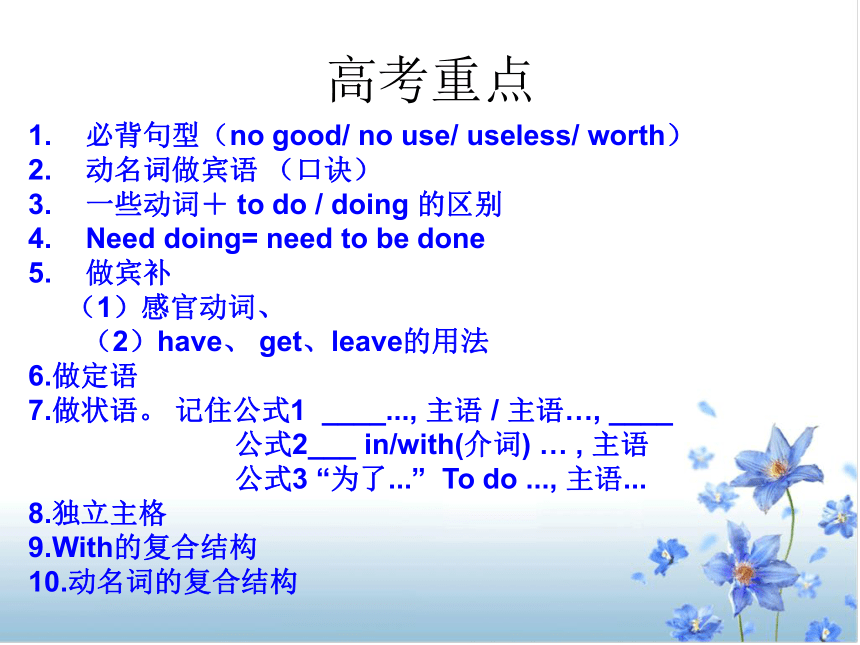



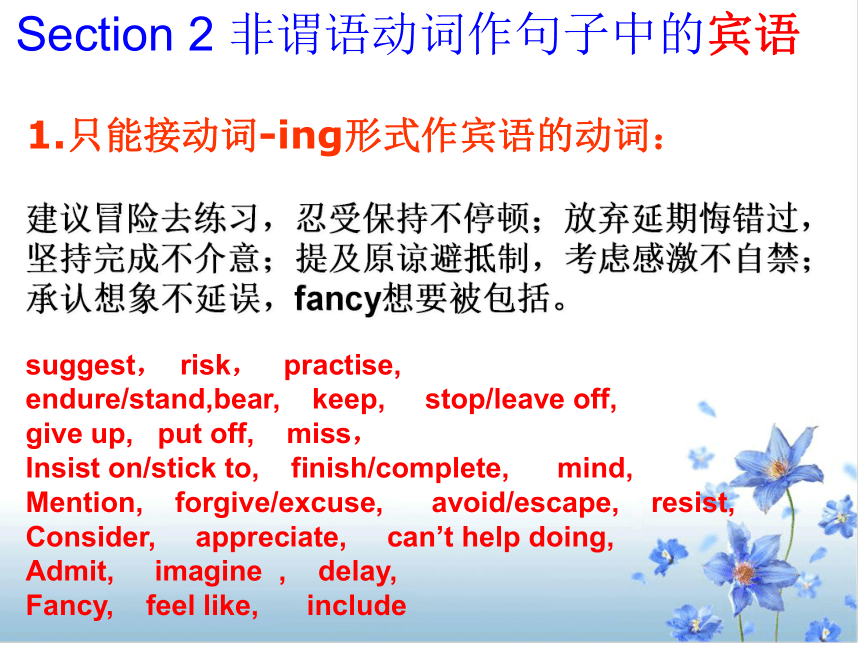

文档简介
(共34张PPT)
讲义篇
高三语法复习-------非谓语动词
谓语动词
一般 进行 完成 完成进行
过去 did was/were was/were doing had done had been doing
现在 do/does is/am/are is/am/are doing has/have done has/have been doing
将来 will do is/am/are going to do is/am/are about to do is/am/are to do will be doing will have done will have been doing
过去将来 would do was/were going to do was/were about to do was/were to do
动词的非谓语形式
形式 属性 主语 宾语 表语 定语 状语 补语
to do n./adj./adv. y y y y y y
doing n. y y y y
v-ed adj./adv. y y y y
v-ing adj./adv. y y y y
(not) to do
主动 被动
一般 to do to be done
进行 to be doing
完成 to have done to have been done
完成进行 to have been doing
It’s easy to say.
He seems to be fond of playing the guitar.
(not)doing动名词
Walking quickly on the muddy road is difficult.
Jenny’s not coming made him unhappy.
Being misunderstood by others makes him feel so depressed.
主动 被动
一般式 doing being done
(not) v-ing现在分词
Finding the door unlocked, I went into the kitchen.
The girls were walking along the country road, singing and dancing.
主动 被动
进行 doing being done
完成 having done having been done
高考重点
必背句型(no good/ no use/ useless/ worth)
动名词做宾语 (口诀)
一些动词+ to do / doing 的区别
Need doing= need to be done
做宾补
(1)感官动词、
(2)have、 get、leave的用法
6.做定语
7.做状语。 记住公式1 ____..., 主语 / 主语…, ____
公式2___ in/with(介词) … , 主语
公式3 “为了...” To do ..., 主语...
8.独立主格
9.With的复合结构
10.动名词的复合结构
to do
形式上 doing
done
Section 1. 非谓语动词作句子的主语
to do /doing 作主语没有太大的区别,表示一般的抽象概念用doing,表示具体的个别的将来的用to do .
Collecting stamps is my hobby.
To sing this song is what I really want to do now.
另外,可用作形式主语或形式宾语结构中,用it 作形式主/宾语.
(用 for 或of 来表示逻辑主语.for 不定式的特点;of 人的特点)
1.It’s difficult for you to study English.
2.It’s foolish of you to ask her for help.
3. It’s no use doing too much exercises.
必 背
动词-ing形式作主语的几个常用句型。
It’s no good talking to him. 和他谈话是没好处的。
It is useless/no use telephoning him. He is not willing to come.
给他打电话没用。他不愿意来。
It‘s worth making an effort. 努力一下是值得的。
1.只能接动词-ing形式作宾语的动词:
建议冒险去练习,忍受保持不停顿;放弃延期悔错过,坚持完成不介意;提及原谅避抵制,考虑感激不自禁;
承认想象不延误,fancy想要被包括。
suggest, risk, practise,
endure/stand,bear, keep, stop/leave off,
give up, put off, miss,
Insist on/stick to, finish/complete, mind,
Mention, forgive/excuse, avoid/escape, resist,
Consider, appreciate, can’t help doing,
Admit, imagine , delay,
Fancy, feel like, include
Section 2 非谓语动词作句子中的宾语
2.to do 作宾语 e.g. hope to do sth
wish, hope, agree, ask, promise,
decide, expect, manage, offer, pretend,
plan, refuse, care, fail(fail to do 没能做成), afford, determine.
I didn’t fancy swimming in that water.
I wish you' d leave off whistling like that.
请你不要那样吹口哨了.
另外一,请注意需要区别的地方:
regret to do表示没做
forget
remember doing表示做完.
try to do (努力)/ try doing(尝试)
mean to do(打算) / mean doing (意味着)
regret doing 对于已经做过的事情感到后悔
regret not doing 对于未做的事情感到遗憾.
regret to do 对于即将要做的事情感到遗憾。
Eg. 1.很遗憾的告诉你,这次你考试又没过。
I regret to say / tell /inform you that you've failed again this time.
2.我很遗憾昨天没能参加你的舞会。
I regret not going to your party yesterday.
另外二,need, require, want,deserve
(eg. Need doing = need to be done)
☆need, require, want作“需要”解,deserve 做“应当,值得”,后面接动词-ing形式的主动形式或不定式的被动形式,意义上并无差别,但用动词-ing形式比较普通。
Your composition needs correcting / to be corrected.
你的作文需要修改。
His coat wants cleaning / to be cleaned.
他的外套需要洗了。
The old woman requires looking after carefully / to be looked after carefully.
这个老大娘需要细心地照料。
第一类:感官动词( see, hear, feel, watch, notice, observe, smell,. )
Section 3 非谓语动词作句子中的宾补
doing sth
see sb do sth
done sth
表动作在进行
表全过程,完成
表被动
1. I saw him playing in the park just now.
2. I saw him make a model plane.
3. I saw a dog tied to a chair.
在上面这个固定搭配中,sb. 是非谓语动词的逻辑主语
第二类:可接to do做宾补的词:
request sb to do sth(在这个结构中,sb. 是to do 的逻辑主语)
permit, allow, forbid, request, command, tell, invite, cause, encourage, warn, advise, persuade, force, order, remind, teach,
permit, allow, forbid, advise后也可以直接加doing做宾语
注意:一、have的四种用法
have sb/ sth done 让…被
have sb /sth doing 让…一直
have sb / sth do 让…做
have
有:have sb/sth to do
使,让
get sb/ sth done 使…被
get sb /sth doing使…开始
get sb to do 让…做
注意:二、get的用法
The captain got the soldiers moving toward the front after a short rest.
休息片刻之后,上尉让士兵们开始朝前线行进起来.
注意: 三、leave 的用法
leave sb/sth doing 使...一直做
leave sb/sth to do让…去做
leave sth undone留下…未做
Section 4 非谓语动词作句子中的定语
n +
doing
done
to do
to be done
being done
主动和进行
被动和过去
将来的主动
将来的被动
正在进行的被动
在这个结构中,被修饰的n是非谓语动词的逻辑主语。
The plan discussed yesterday is a good one.
The boy to go to school next year is my son.
The plan to be discussed tomorrow is a good one.
The plan being discussed at present is a good one.
The boy going to school now is my son.
下面这些词多接to do 作定语
the first…, the last…, the only,time, place, way,最高级,all , no,any
e.g He's always the first (one) to come to school.
I must find a way to save them.
He has no place to live in.
We have no time to lose.
注意:非谓语动词作定语应该注意
1.to do做状语
(1)表示原因,目的或结果。为了强调目的,可与in order to 或so as to 连用。to do的否定式为not to do
He got up early (in order)to catch the early bus . 目的
I’m so glad to see you. 原因
They went to the railway station, only to be told that the train had left. 出乎意料的结果
注: (1)“only to do”表示出乎预料的结果.
(2)doing表自然而然的结果。
Eg. Many people like playing football, making it popular around the world .
Section 5 非谓语动词作句子中的状语:
2.doing , done 作状语
分词作状语可以表示时间,条件,原因,结果,伴随或方式 ,及
独立成分。
doing
done
having done
having been done
主动和进行
被动和过去
主动,表示动作先于谓语动词发生
被动
1.Seeing from the top of the hill, I found the school is beautiful.
2.Seen from the top of the hill , the school is very beautiful.
3. See from the top of the hill , and you will find the school is beautiful.
4.Having finished my homework, I went home immediately.
5.Having been beaten by my father, I went out to see my mother .
6.Not having received his letter, he went home
= Having never received his letter , he went home .
否定式要把not加-ing在前面,或把never加在-ing后面.
以上的句子中,非谓语动词的逻辑主语与句子的主语是一致的
________......, 主语
主语….,________
下列少数短语为惯用语,为固定形式。
Judging from/by , generally speaking ,
honestly speaking , strictly speaking ,
talking of , speaking of .
Providing / provided(that ), Assuming(that),Supposing/suppose(that ), given (倘若), Concerning , allowing for 考虑到…,
如果非谓语动词的逻辑主语与句子的主语不是一致呢?
1.独立主格结构
Weather permitting, we will go out for a picnic
tomorrow.
It being Sunday, we have no classes .
There being no bus, we had to walk home.
2.With 复合结构 , 做定语, 状语
to do
doing
With + n done
adj
adv
prep
主动,进行
被动,完成
表状态
表状态
表将来的主动/被动
表状态
1.He sits here, with his feet pointing to the others .
2.He sits here, with his hands tied to the chair.
3.The boy is playing out side, with his face red .
4.The boy stays at home , with his mother out .
5. The teacher walks into the classroom, with a
book in his hand .
6. He went home , with his homework to do .
3.动名词的复合结构
Do you mind opening the window
Do you mind my / me opening the window
His being late again made the teacher angry.
讲义篇
高三语法复习-------非谓语动词
谓语动词
一般 进行 完成 完成进行
过去 did was/were was/were doing had done had been doing
现在 do/does is/am/are is/am/are doing has/have done has/have been doing
将来 will do is/am/are going to do is/am/are about to do is/am/are to do will be doing will have done will have been doing
过去将来 would do was/were going to do was/were about to do was/were to do
动词的非谓语形式
形式 属性 主语 宾语 表语 定语 状语 补语
to do n./adj./adv. y y y y y y
doing n. y y y y
v-ed adj./adv. y y y y
v-ing adj./adv. y y y y
(not) to do
主动 被动
一般 to do to be done
进行 to be doing
完成 to have done to have been done
完成进行 to have been doing
It’s easy to say.
He seems to be fond of playing the guitar.
(not)doing动名词
Walking quickly on the muddy road is difficult.
Jenny’s not coming made him unhappy.
Being misunderstood by others makes him feel so depressed.
主动 被动
一般式 doing being done
(not) v-ing现在分词
Finding the door unlocked, I went into the kitchen.
The girls were walking along the country road, singing and dancing.
主动 被动
进行 doing being done
完成 having done having been done
高考重点
必背句型(no good/ no use/ useless/ worth)
动名词做宾语 (口诀)
一些动词+ to do / doing 的区别
Need doing= need to be done
做宾补
(1)感官动词、
(2)have、 get、leave的用法
6.做定语
7.做状语。 记住公式1 ____..., 主语 / 主语…, ____
公式2___ in/with(介词) … , 主语
公式3 “为了...” To do ..., 主语...
8.独立主格
9.With的复合结构
10.动名词的复合结构
to do
形式上 doing
done
Section 1. 非谓语动词作句子的主语
to do /doing 作主语没有太大的区别,表示一般的抽象概念用doing,表示具体的个别的将来的用to do .
Collecting stamps is my hobby.
To sing this song is what I really want to do now.
另外,可用作形式主语或形式宾语结构中,用it 作形式主/宾语.
(用 for 或of 来表示逻辑主语.for 不定式的特点;of 人的特点)
1.It’s difficult for you to study English.
2.It’s foolish of you to ask her for help.
3. It’s no use doing too much exercises.
必 背
动词-ing形式作主语的几个常用句型。
It’s no good talking to him. 和他谈话是没好处的。
It is useless/no use telephoning him. He is not willing to come.
给他打电话没用。他不愿意来。
It‘s worth making an effort. 努力一下是值得的。
1.只能接动词-ing形式作宾语的动词:
建议冒险去练习,忍受保持不停顿;放弃延期悔错过,坚持完成不介意;提及原谅避抵制,考虑感激不自禁;
承认想象不延误,fancy想要被包括。
suggest, risk, practise,
endure/stand,bear, keep, stop/leave off,
give up, put off, miss,
Insist on/stick to, finish/complete, mind,
Mention, forgive/excuse, avoid/escape, resist,
Consider, appreciate, can’t help doing,
Admit, imagine , delay,
Fancy, feel like, include
Section 2 非谓语动词作句子中的宾语
2.to do 作宾语 e.g. hope to do sth
wish, hope, agree, ask, promise,
decide, expect, manage, offer, pretend,
plan, refuse, care, fail(fail to do 没能做成), afford, determine.
I didn’t fancy swimming in that water.
I wish you' d leave off whistling like that.
请你不要那样吹口哨了.
另外一,请注意需要区别的地方:
regret to do表示没做
forget
remember doing表示做完.
try to do (努力)/ try doing(尝试)
mean to do(打算) / mean doing (意味着)
regret doing 对于已经做过的事情感到后悔
regret not doing 对于未做的事情感到遗憾.
regret to do 对于即将要做的事情感到遗憾。
Eg. 1.很遗憾的告诉你,这次你考试又没过。
I regret to say / tell /inform you that you've failed again this time.
2.我很遗憾昨天没能参加你的舞会。
I regret not going to your party yesterday.
另外二,need, require, want,deserve
(eg. Need doing = need to be done)
☆need, require, want作“需要”解,deserve 做“应当,值得”,后面接动词-ing形式的主动形式或不定式的被动形式,意义上并无差别,但用动词-ing形式比较普通。
Your composition needs correcting / to be corrected.
你的作文需要修改。
His coat wants cleaning / to be cleaned.
他的外套需要洗了。
The old woman requires looking after carefully / to be looked after carefully.
这个老大娘需要细心地照料。
第一类:感官动词( see, hear, feel, watch, notice, observe, smell,. )
Section 3 非谓语动词作句子中的宾补
doing sth
see sb do sth
done sth
表动作在进行
表全过程,完成
表被动
1. I saw him playing in the park just now.
2. I saw him make a model plane.
3. I saw a dog tied to a chair.
在上面这个固定搭配中,sb. 是非谓语动词的逻辑主语
第二类:可接to do做宾补的词:
request sb to do sth(在这个结构中,sb. 是to do 的逻辑主语)
permit, allow, forbid, request, command, tell, invite, cause, encourage, warn, advise, persuade, force, order, remind, teach,
permit, allow, forbid, advise后也可以直接加doing做宾语
注意:一、have的四种用法
have sb/ sth done 让…被
have sb /sth doing 让…一直
have sb / sth do 让…做
have
有:have sb/sth to do
使,让
get sb/ sth done 使…被
get sb /sth doing使…开始
get sb to do 让…做
注意:二、get的用法
The captain got the soldiers moving toward the front after a short rest.
休息片刻之后,上尉让士兵们开始朝前线行进起来.
注意: 三、leave 的用法
leave sb/sth doing 使...一直做
leave sb/sth to do让…去做
leave sth undone留下…未做
Section 4 非谓语动词作句子中的定语
n +
doing
done
to do
to be done
being done
主动和进行
被动和过去
将来的主动
将来的被动
正在进行的被动
在这个结构中,被修饰的n是非谓语动词的逻辑主语。
The plan discussed yesterday is a good one.
The boy to go to school next year is my son.
The plan to be discussed tomorrow is a good one.
The plan being discussed at present is a good one.
The boy going to school now is my son.
下面这些词多接to do 作定语
the first…, the last…, the only,time, place, way,最高级,all , no,any
e.g He's always the first (one) to come to school.
I must find a way to save them.
He has no place to live in.
We have no time to lose.
注意:非谓语动词作定语应该注意
1.to do做状语
(1)表示原因,目的或结果。为了强调目的,可与in order to 或so as to 连用。to do的否定式为not to do
He got up early (in order)to catch the early bus . 目的
I’m so glad to see you. 原因
They went to the railway station, only to be told that the train had left. 出乎意料的结果
注: (1)“only to do”表示出乎预料的结果.
(2)doing表自然而然的结果。
Eg. Many people like playing football, making it popular around the world .
Section 5 非谓语动词作句子中的状语:
2.doing , done 作状语
分词作状语可以表示时间,条件,原因,结果,伴随或方式 ,及
独立成分。
doing
done
having done
having been done
主动和进行
被动和过去
主动,表示动作先于谓语动词发生
被动
1.Seeing from the top of the hill, I found the school is beautiful.
2.Seen from the top of the hill , the school is very beautiful.
3. See from the top of the hill , and you will find the school is beautiful.
4.Having finished my homework, I went home immediately.
5.Having been beaten by my father, I went out to see my mother .
6.Not having received his letter, he went home
= Having never received his letter , he went home .
否定式要把not加-ing在前面,或把never加在-ing后面.
以上的句子中,非谓语动词的逻辑主语与句子的主语是一致的
________......, 主语
主语….,________
下列少数短语为惯用语,为固定形式。
Judging from/by , generally speaking ,
honestly speaking , strictly speaking ,
talking of , speaking of .
Providing / provided(that ), Assuming(that),Supposing/suppose(that ), given (倘若), Concerning , allowing for 考虑到…,
如果非谓语动词的逻辑主语与句子的主语不是一致呢?
1.独立主格结构
Weather permitting, we will go out for a picnic
tomorrow.
It being Sunday, we have no classes .
There being no bus, we had to walk home.
2.With 复合结构 , 做定语, 状语
to do
doing
With + n done
adj
adv
prep
主动,进行
被动,完成
表状态
表状态
表将来的主动/被动
表状态
1.He sits here, with his feet pointing to the others .
2.He sits here, with his hands tied to the chair.
3.The boy is playing out side, with his face red .
4.The boy stays at home , with his mother out .
5. The teacher walks into the classroom, with a
book in his hand .
6. He went home , with his homework to do .
3.动名词的复合结构
Do you mind opening the window
Do you mind my / me opening the window
His being late again made the teacher angry.
